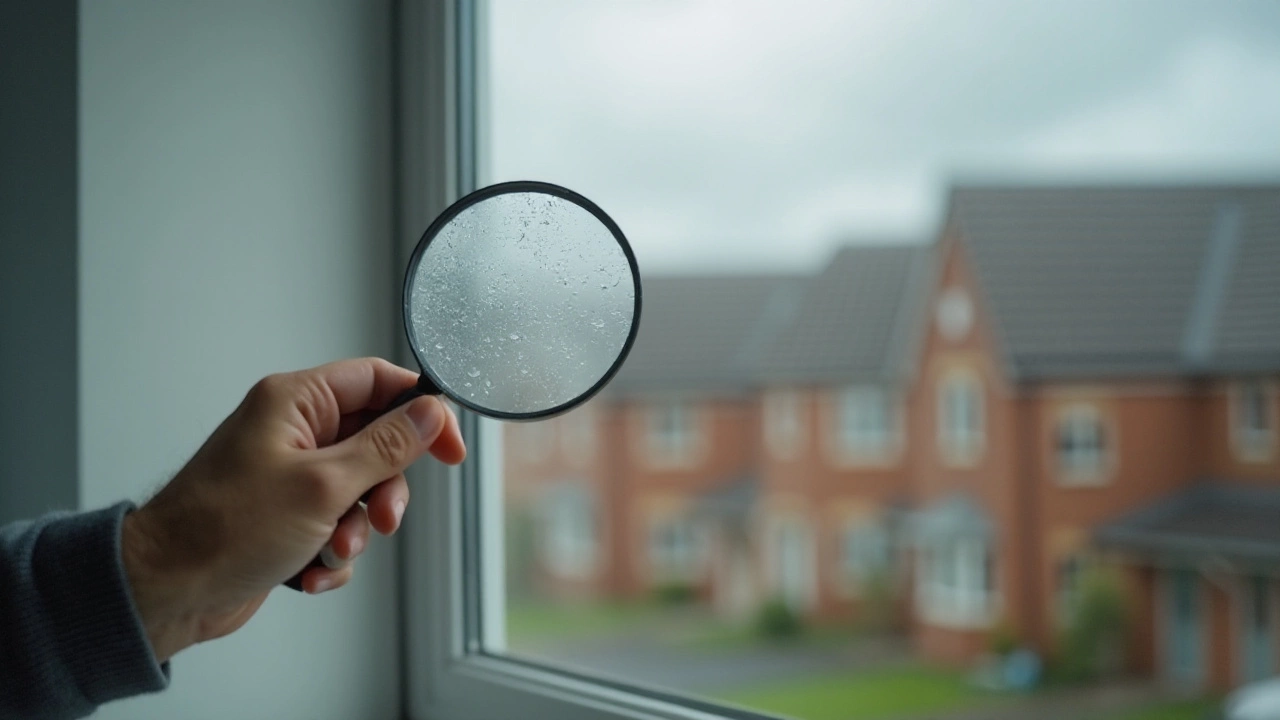Purchasing a new home is a significant milestone, often filled with excitement and anticipation. However, new builds don't always come without issues. Understanding what constitutes a defect is essential to ensure your new home meets both safety and quality standards.
Defects can vary widely in their nature and impact. Some are minor and easily fixable, while others might require more significant attention. Knowing what to look out for not only helps you address issues as they arise but also empowers you to communicate effectively with builders to seek timely solutions.
- Defining Construction Defects
- Common Defects in New Builds
- Causes of Construction Defects
- Identifying Defects Early
- Legal Rights and Responsibilities
- Preventive Measures and Solutions
Defining Construction Defects
In the realm of new construction, the term "defect" is often a source of confusion for both homeowners and builders. Simply put, a construction defect refers to any condition in a newly built structure that fails to meet the standards set by local building codes, industry standards, or the specific warranty provided by the builder. These defects can arise in various ways, from poor craftsmanship and substandard materials to inadequate design and planning. A profound understanding of what constitutes a defect is crucial in safeguarding one’s investment in a new home.
Construction defects can be broadly categorized into four groups: design deficiencies, material deficiencies, construction deficiencies, and subsurface deficiencies. Each category comes with its own set of characteristics and challenges. Design defects usually manifest when architects or engineers fail to create plans that comply with structural codes or fail to consider common environmental stresses. Material deficiencies arise when inferior materials are used that deteriorate prematurely, or don’t hold up to promised standards, potentially leading to severe issues like water intrusion.
Construction Deficiencies
These occur when the workmanship does not meet the specified standards, resulting in structural issues or safety hazards. For instance, poorly installed roofing might lead to leaks, while improperly sealed windows could lead to drafts and water ingress. Subsurface deficiencies are related to problems with the land upon which the building is constructed. These can result in foundation issues like settling or shifting, often requiring significant remediation efforts.
As stated by the National Association of Home Builders, ensuring quality control throughout the construction process is crucial in reducing the likelihood of defects, as nearly 30% of new homebuyers report issues within their first year of ownership.
Homeowners should be particularly vigilant during the warranty period, often referred to as the "defect liability period." During this time, builders are typically responsible for rectifying any defects identified, provided they fall within the scope of what the warranty covers. Regular inspections by qualified professionals are highly recommended, as they can help identify and document any defects before this period lapses. Moreover, homeowners can educate themselves on potential warning signs of construction issues, such as cracks in the foundation, unexplained dampness, or unusual noises within walls and floors.
In some cases, disputes over construction defects may arise, necessitating legal intervention. Legal definitions of defects can vary significantly depending on jurisdiction, as can the recourse available to affected homeowners. It is important to know your rights and obligations as a homeowner within your locality, and to seek professional advice if necessary. Ultimately, being proactive and informed can not only help prevent defects from worsening but also ensure a higher standard of living in newfound homes.
Common Defects in New Builds
New homes are often expected to epitomize perfection, providing comfort and security straight out of the box. Yet, even with the most meticulous construction processes, snags and flaws can appear once homebuyers begin to settle in. It's a reality many face, from peeling paint and cracked walls to more severe structural issues. These defects vary greatly, impacting both aesthetics and functionality. Identifying them early can save homeowners a significant amount of headache and money. Sometimes, these defects stem from rushed schedules or cutting corners due to budget constraints, but other times they might result from honest oversights. Ensuring quality in new constructions is not just about materials or design but also about execution and attention to the minute details that matter most in making a house a home.
Some of the most prevalent new build defects include issues with plumbing and drainage, which might manifest as leaks or ineffective water flow. Imagine the frustration of dealing with a constantly dripping faucet or a toilet that refuses to flush correctly—it can transform the joy of a new home into a relentless barrage of annoyance. Inadequate insulation is another common problem; houses without sufficient insulation suffer from poor energy efficiency, leading to uncomfortable temperature variations and inflated utility bills. Insulation is not just about comfort; it’s about sustainability and reduced environmental impact. Ensuring your house is properly insulated is a critical step towards a more eco-friendly lifestyle.
Cracks in the walls or ceiling are other frequently reported issues. They might not appear immediately but can start to show once the house settles. While some cracks are merely cosmetic, others can indicate deeper problems with the house's foundation or structural integrity. These more serious defects require immediate attention to prevent them from escalating into significant issues. Electrical faults also pose frequent headaches, from outlets that don’t work to lights that flicker mysteriously. Such issues are not just inconveniences; they can be safety hazards if left unaddressed.
"The devil is in the details, as they say," notes a respected home inspector, emphasizing the need for thorough scrutiny, even in brand-new properties.
Another aspect that often slips under the radar is the poor quality of materials used in construction. Sometimes, builders might use substandard materials to cut costs, which can lead to quicker wear and tear. This can be particularly affecting when considering elements like flooring and woodwork that endure daily wear. Doors that don’t close properly, gaps in flooring, and tired-looking woodwork can diminish the newness that homeowners treasure.
With construction issues, it’s always wise to have a well-documented snagging list that details all the defects and ensures they are addressed before any warranty expires. Many homeowners also find peace of mind in hiring an independent inspector to conduct a thorough check of the property. Through this proactive approach, many hidden defects can be caught early, safeguarding the investment in your new home and ensuring that your comfort and safety remain a top priority.

Causes of Construction Defects
Tackling the reasons behind construction issues helps in understanding why new builds might have flaws. One of the main causes is inadequate planning and design. Without thorough blueprints and a clear architectural vision, even small mistakes can become big problems. Engineers and architects play critical roles, and if there's a gap in their collaboration or if design documents lack detail, this can lead to costly errors on the site. Even elements like site conditions, such as soil stability, need careful consideration during the design phase to prevent future complications.
Another significant contributor is poor material quality. Builders might sometimes opt for low-grade materials to cut costs, not realizing this decision can lead to compromised structural integrity. When the quality of materials like timber, concrete, or fittings is subpar, the potential for defects increases exponentially. This is often exacerbated by subcontractor errors where, due to staff or budget constraints, tasks like plumbing or electrical systems aren’t executed to standards. Consistent quality control measures throughout the construction process can mitigate these risks, ensuring the building quality remains unaffected.
An equally pressing issue is improper or rushed construction practices. Often, due to project timelines or budget constraints, building teams work under pressure, leading to oversight in critical areas. When contractors cut corners to speed up completion, it can result in defects that may surface long after the home is occupied. For example, moisture-related issues due to improper waterproofing or incorrect roofing techniques are common and can result in significant repair costs. This rushing not only jeopardizes the longevity of the build but can also severely affect the aesthetic and functional value of the property.
Finally, it’s worth noting that external factors, such as changes in building codes or weather conditions during construction, can also play a part. As new regulations get implemented, sometimes mid-project, adapting plans to comply with new standards might not always be seamless. Construction projects carried out in adverse weather, without adequate protection plans, suffer too, often leading to moisture management issues or frozen materials that weren’t cured or set properly. This step, crucial yet often neglected, can make a substantial difference in mitigating new build defects.
"A substantial number of construction defects are directly related to inadequate oversight during key phases of building," commented industry veteran John Doe in a recent publication from Architectural Digest. "Ensuring there is constant and rigorous inspection can prevent many common faults before they become systemic."
Identifying Defects Early
Spotting defects in a new build early can save homeowners a great deal of headache and expense. Within the excitement of moving into a brand-new home, small but significant issues can sometimes go unnoticed. Conducting a thorough inspection as soon as the keys are handed over is a crucial step. This is not only about checking for visible issues like cracks or incomplete finishes but also ensuring that all systems and appliances are functioning properly.
A keen eye is necessary, especially for hidden issues. Common new build defects might include misaligned doors, uneven floors, and poorly fitted windows. Homeowners should look beyond the surface aesthetics. Small details like the caulking around windows and the consistency of paintwork can be telling as well. It is also wise to engage a professional home inspector who can provide an impartial assessment of the property. An expert inspector will know exactly where to look and what to look for, making them invaluable in this process.
Structural and Mechanical Checks
Inspecting the structural and mechanical systems is essential. This encompasses checking the plumbing for leaks, ensuring the heating and cooling systems are operational, and confirming that the electrical system meets safety standards. Many defects become evident during the first few months of use, making it a good practice to keep detailed notes of any irregularities during this period. Owners should not hesitate to document issues as they are discovered, often supported by photographs.It is also beneficial to understand the timeline for when defects generally surface in new builds. Most owners experience issues related to settlement within the first year; these include cracks in walls or ceilings and doors or windows that don’t close properly due to shifts in structure. Awareness of these common timelines can help in identifying defects early before they become major issues. Engage builders promptly with detailed descriptions of defects, which sometimes employs anecdotal evidence from other recent projects.
"In our experience, defects identified within the first year are much easier to address, and builders are more likely to cooperate when issues are documented and reported swiftly," advises a seasoned home inspector from a leading agency.
In sum, being proactive and conducting a meticulous examination of your new build can prevent minor issues from escalating into costly repairs. Make it a priority to review every corner, system, and structural aspect of your new home to avoid surprises down the line. It's an investment of time that could save both money and frustration in the years to come, helping ensure the quality of your new residence aligns with your expectations.

Legal Rights and Responsibilities
When diving into the realm of new builds, it is imperative to understand your legal rights and responsibilities as a homeowner. These can protect you from unforeseen expenses and ensure that your home meets necessary standards. Builders are typically required to provide a warranty, covering specific types of defects that may arise post-construction. These warranties might vary by region, but there are commonalities. In many jurisdictions, structural defects that compromise the safety and integrity of a home are covered for a longer duration than cosmetic issues like paint or fixtures.
The period of coverage under these warranties can vary. For instance, some regions mandate that builders cover major structural defects for up to ten years, while smaller defects might only be covered for up to two years. It's essential to be familiar with the nuances of these warranties and what exactly they cover. Equally important is the process for making a claim. Claims often require documentation of the defect, as well as a record of attempts to resolve the issue with your builder. Keeping detailed records can facilitate this process significantly.
"Understanding your rights in the construction realm is foundational. Too often, homeowners feel overwhelmed and unsure about the pathways to address defects," says industry expert, Linda Mitchell, in her seminal work on home warranties.
There are also obligations on the homeowner's part to ensure the warranty remains in effect. This may include proper home maintenance and notifying the builder of any defects within a specified timeline. Failing to follow these stipulations could void your coverage, leaving you liable for repair costs.
Moreover, should disagreements arise between you and the builder about the nature or cause of the defect, many warranties encourage or require mediation or arbitration as a first step. These alternative dispute resolution mechanisms can offer a more cost-effective and faster resolution than litigation. Knowing these legal avenues is crucial in ensuring that both you and the builder are clear about expectations and responsibilities from the outset. Graphical representation can also help in understanding key points:
| Coverage Type | Typical Duration |
|---|---|
| Structural Defects | 10 years |
| Non-structural Issues | 2 years |
In conclusion, staying informed about your legal rights and responsibilities in new constructions helps mitigate stress and ensures a productive relationship with your builder. Protecting yourself means addressing any construction issues promptly and maintaining open lines of communication. Knowledge is indeed power, especially when it comes to investing in your home.
Preventive Measures and Solutions
When aiming to avoid defects in new builds, a proactive approach can save a great deal of time and resources. One of the most effective strategies is engaging in thorough research and careful planning even before construction begins. This means clearly communicating expectations with the builder and ensuring that all plans detail the necessary specifications. It's crucial to set up regular check-ins and address any concerns quickly to preempt potential issues from escalating.
Building a good relationship with your contractor or developer can't be overstressed. Frequent, transparent communication can bridge differences and ensure everyone is on the same page. Encourage open dialogue about any construction issues, as this shared understanding can significantly reduce risks of construction issues later. Keeping a detailed log of communications also helps you track progress and understand decision-making processes.
Homeowners should also consider hiring a professional home inspector, not only at the end of the project but at different stages of construction. An inspector brings an unbiased eye and has the specialized knowledge needed to spot defects that might elude even a seasoned builder. In fact, data from industry surveys show that independent inspections can detect up to 80% of common issues early on, preventing costly repairs down the line.
"An ounce of prevention is worth a pound of cure," said Benjamin Franklin, and this holds especially true when it comes to new build defects. Avoiding these problems at the outset through diligent oversight is far less burdensome than dealing with them after they have manifested.
Utilizing Quality Materials
Choosing high-quality, tried-and-tested materials is another essential step. While it might be tempting to cut costs by opting for cheaper alternatives, this often translates to higher expenses in the long run due to repairs and replacements. Ensuring that materials meet industry standards and are suitable for the specific environment will go a long way in minimizing defects.
Finally, once the construction is complete, regular maintenance should not be overlooked. A well-maintained property is less prone to developing problems. This includes routine checks of key areas such as roofing, plumbing, and electrical systems to catch any emerging issues early.





